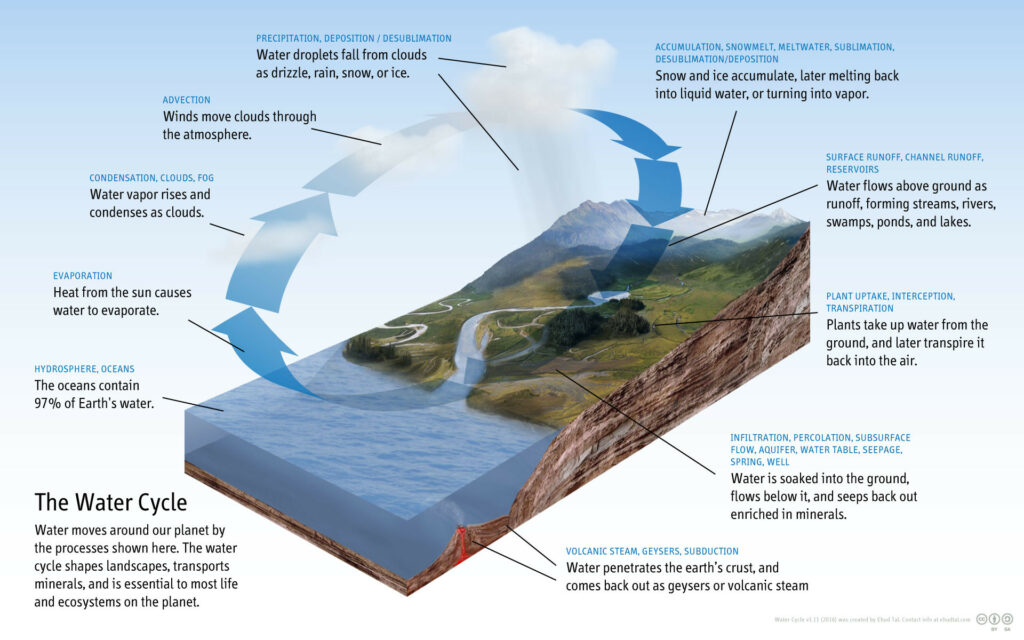The Water Cycle or Hydrologic Cycle
The water cycle involves the continuous circulation of water in the Earth-atmosphere system. Water is transferred from the oceans through the atmosphere to the continents and back to the oceans by means of
Evaporation: Water vapour with the aid of heat, rising from the soil to the atmosphere
Transpiration: Water vapour with the aid of heat and growth rising from plant to the atmosphere
Precipitation: From the atmosphere to the earth Rain, snow, hails, sleet, etc
Also: Overland flow, runoff, and other complex processes.

This file is licensed under the Creative Commons Attribution-Share Alike 4.0 International license.
Although the total amount of water within the cycle remains essentially constant, its distribution among the various processes is continually changing.
The Water cycle and climate change
Climate change is likely causing parts of the water cycle to speed up as warming global temperatures increase the rate of evaporation worldwide.
Higher evaporation and precipitation rates are not evenly distributed around the world. Some areas may experience heavier than normal precipitation, and other areas may become prone to droughts, as the traditional locations of rain belts and deserts shift in response to a changing climate.
The water cycle and farming.
The water cycle is essential to farming practices while farming can also affect the water cycle. Plants don’t just use water to live but they and the soil, can trap and release water at different rates. Evapotranspiration is the release of moisture from plants and can have an impact on humidity and instability. A warm humid atmosphere can lead to heavier rainfall and can be primed for convective development (showers). So if the air is warm, moist and unstable enough, imagining a parcel of air that is warmer than the surrounding air but doesn’t mix with it, clouds will form at a specific level and may produce precipitation completing the cycle. If the parcel remains warmer than the air around it, it will continue to rise, if nothing is inhibiting it, like a relatively warmer layer of air, it will continue to rise to produce heavier showers or thunderstorm.
If there is something inhibiting the convection the warm moist air will make it feel very humid but it will eventually be redistributed elsewhere and the water may fall as rain elsewhere, this can lead to uneven distribution of rainfall, which in turn can lead to regions of flooding and drought.
A balance is important for farming, and Irelands more temperate climate usually doesn’t lead to extremes of drought or excessive rainfall, however with the changing climate, we have already seen more instances of extremes which can be very detrimental to the farming industry, if they increase in intensity and frequency, which is anticipated. This may also put stresses on not just rivers and lakes but any water source for animals or indeed humans.
It also should be noted that in warmer regions we get areas of extreme drought or indeed regions of persistent rainfall. They also tend to repeat their own cycles with drier air leading to less rainfall and this is seen in deserts, while wetter areas lead to more rainfall like in the rainforests. As the planet warms more regions will be divided between these extremes